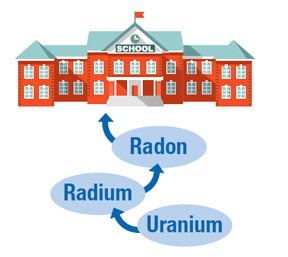Radon
What is Radon?
 Radon comes from natural deposits of uranium in the soil. It is found everywhere in the world. Uranium naturally decays into radium that further breaks down into radon gas. While some geographic areas have more radon than others, the only way to determine a building’s radon level is to test it. Any building has the potential for elevated levels of radon. Because radon is a gas, it can move up through the soil, allowing it to enter buildings in contact with the soil. Radon is typically at its highest concentration in the lower portion of a building. Once radon enters a building, it is easily dispersed through the air. It then begins a radioactive decay process that leads to creating radon decay products. Radon gas itself is relatively harmless until it produces these decay products. The decay products release damaging energy particles that strike lung tissue and lead to lung tissue damage if inhaled.
Radon comes from natural deposits of uranium in the soil. It is found everywhere in the world. Uranium naturally decays into radium that further breaks down into radon gas. While some geographic areas have more radon than others, the only way to determine a building’s radon level is to test it. Any building has the potential for elevated levels of radon. Because radon is a gas, it can move up through the soil, allowing it to enter buildings in contact with the soil. Radon is typically at its highest concentration in the lower portion of a building. Once radon enters a building, it is easily dispersed through the air. It then begins a radioactive decay process that leads to creating radon decay products. Radon gas itself is relatively harmless until it produces these decay products. The decay products release damaging energy particles that strike lung tissue and lead to lung tissue damage if inhaled.
(Source: Testing for Elevated Radon in Oregon Schools: A Protocol and Plan, Version 1.0 – 2016, Oregon Health Authority Public Health Division, p. 8)
Radon Plan
Information
Regulation Information
Contact Safety
"*" indicates required fields
